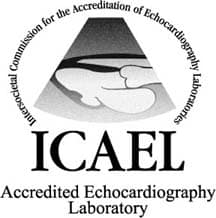Issues with AT&T customers contacting us. Some AT&T customers are having trouble calling us, "the listed phone number is not in service." Please read more here


 Echocardiography is an ultrasound technique to visualize cardiac structures. Sound waves are transmitted from a hand-held wand to the heart. Solid structures reflect sound waves to the probe and information transferred to the console. A computer uses the characteristics of the reflected sound waves to construct a moving image of the heart. Sound waves can also be transmitted in such a way to reflect off blood cells and gain insights into the blood flow within the heart. This is the “Doppler principle,” also used in weather forecasting.
Echocardiography is an ultrasound technique to visualize cardiac structures. Sound waves are transmitted from a hand-held wand to the heart. Solid structures reflect sound waves to the probe and information transferred to the console. A computer uses the characteristics of the reflected sound waves to construct a moving image of the heart. Sound waves can also be transmitted in such a way to reflect off blood cells and gain insights into the blood flow within the heart. This is the “Doppler principle,” also used in weather forecasting.
Information from Echocardiography
Echocardiography is the cardiologists’ most versatile tool. The overall pumping function of the heart is evaluated from the ejection fraction (EF), which is the percentage of blood ejected from the left ventricle during each heartbeat. Normal EF is 50% or greater. The motion of each segment of the left ventricle can be reviewed for evidence of a prior heart attack. Studies evaluating the heart’s arteries are typically concerned with the left ventricle only, but “echo” can also visualize the size and function of the other heart chambers, i.e., the right ventricle and right and left atria. These can be affected by various cardiac illnesses. Defects or holes in the heart chambers can also be detected. The heart valves’ structure can also be visualized, and the utilization of Doppler techniques can further characterize abnormalities of the valves. These include abnormally tight valves (“stenotic”) or leaky (‘regurgitant”). Other abnormal valve structure and motion types can be identified, notably mitral valve prolapse. The initial portion of the aorta can also be seen with echo. A covering called the pericardium surrounds the heart. In certain pathologic states, the pericardium may become constricted or tight and fill with fluid. Echocardiography is well suited to detect these problems.
Transesophageal Echocardiography
Standard echocardiography is performed with the wand placed on the patient’s chest wall. This is termed transthoracic echocardiography, meaning the pictures are taken through the chest wall. The ability to visualize small structures can be hampered by sound waves passing through muscle and fat and between the ribs. When better pictures of the heart are needed, a transesophageal echocardiogram (TEE) is utilized. The TEE probe is a long tube that is inserted into the mouth and down into the esophagus. The esophagus is the passageway that leads to the stomach and sits adjacent to the heart and aorta. Image quality is enhanced with less distance for the sound waves to travel. The patient is prepared by coming to the test after fasting. A spray is used to numb the gag reflex in the mouth. Sedating medications are administered through an intravenous catheter.
Specific instances where TEE is valuable are numerous. It readily identifies infections on heart valves, blood clots or tumors, and small holes in the heart. A more comprehensive evaluation of the aorta can be made. It may also supplement transthoracic echocardiography in particular patient subgroups, such as overweight individuals or patients with emphysema (whose enlarged lungs cover the heart and do not allow passage of sound waves from the chest wall).
Preparation for Echocardiography
No preparation is needed for transthoracic echocardiography. For transesophageal echocardiography (TEE), do not eat for eight (8) hours before the test. Medications may be taken with sips of water. Please have a driver available to bring you home after your test is completed.